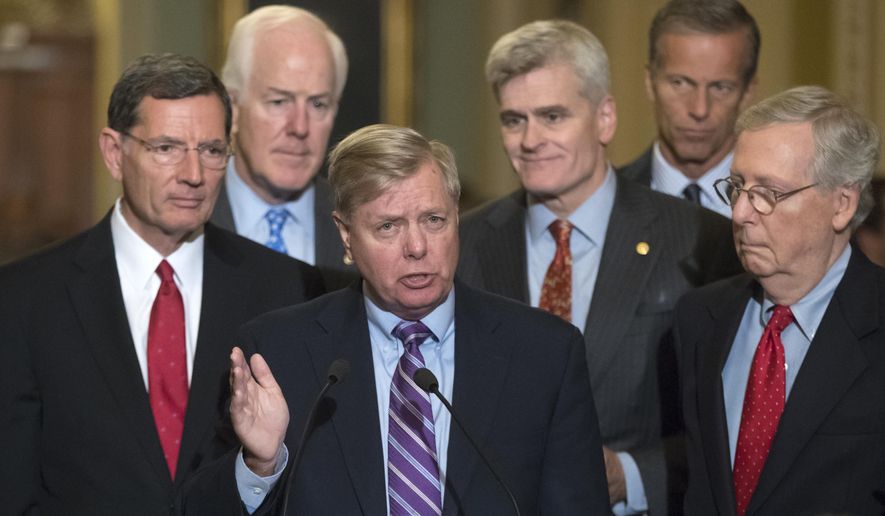The Senate GOP’s last-ditch Obamacare repeal plan would slash federal funding to the states by $215 billion through 2026, analysts said Wednesday in a study that finds less than a third of states would see an increase in funding compared to the current program.
If passed into the law, 34 states and D.C. would see cuts — seven of them would lose more than $10 billion — while 16 states would get more money, particularly Texas, according to Avalere Health, a D.C.-based consultancy.
The last-gasp GOP proposal, sponsored by Sens. Lindsey Graham of South Carolina and Bill Cassidy of Louisiana, would pool Obamacare money that currently subsidizes coverage for many who buy insurance on the exchanges and money going to expand Medicaid rolls, and siphon it all to the states as block grants. The states would tailor the money to their own health care plans starting in 2020.
It’s the last repeal bill standing after the Senate GOP failed to rally around alternatives, though only 15 of the nation’s governors signed onto a Tuesdayletter in support of the state-empowering plan.
“The Graham-Cassidy bill would significantly reduce funding to states over the long term, particularly for states that have already expanded Medicaid,” said Caroline Pearson, senior vice president at Avalere. “States would have broad flexibility to shape their markets but would have less funding to subsidize coverage for low- and middle-income individuals.”
States that would win out through 2026 are predominately red states scattered across the Southeast and Midwest. The most populous state — reliably blue California — would lose nearly $80 billion by 2026, the analysis says.
SEE ALSO: Donald Trump dings Rand Paul, urges Republicans to pass Obamacare replacement plan
Also, the analysis says Florida and North Carolina — states that didn’t expand Medicaid and voted for President Trump, yet enrolled sizable amounts of people into Obamacare’s marketplace — would receive less money over the coming decade.
Avalere says the plan creates a funding cliff in later years, because the block-grant funding expires in 2026.
Mr. Cassidy says not to worry, because the money is funneled through the Children’s Health Insurance Program, which is routinely reauthorized.
But analysts said Congress’ ability to pony up more money “is uncertain and could be constrained by the need to offset the cost.”
Sen. Rand Paul, Kentucky Republican who opposes the plan, has warned colleagues that a future, Democratic-controlled Congress could change the formula to benefit blue states.
Avalere said converting financing to the Medicaid insurance program from an open-ended entitlement to a fixed, per-capita system will have long-term affects, meaning every state should see less money about two decades from now.
“A combination of slower Medicaid per-capita cap growth rates and the sunsetting of block grant funding would lead to substantial reductions in federal funds going to states through 2036,” said Chris Sloan, a senior manager at Avalere. “The largest negative funding impacts of this bill to states are outside the current 10-year budget window.”
Alaska Gov. Bill Walker, an independent, cited Medicaid cuts in signing onto a bipartisan letter from 10 governors that calls on Senate leaders to abandon Graham-Cassidy and pursue a health care fix from both parties.
His voice could influence Sen. Lisa Murkowski, an Alaska Republican who could be the most pivotal holdout among the 52-seat Republican majority.
Republicans are scrambling to pin down at least 50 votes for the bill — Vice President Mike Pence can break the tie — before a Sept. 30 deadline to avoid a Democratic filibuster of their repeal plans under the 2017 budget rules.
Mr. Trump hopped off the sidelines Wednesday and urged Senate Republicans to rally around the plan. He singled out Mr. Paul, who says he will vote “no,” as a friend but a “negative force when it comes to fixing healthcare.”
Rand Paul is a friend of mine but he is such a negative force when it comes to fixing healthcare. Graham-Cassidy Bill is GREAT! Ends Ocare!
— Donald J. Trump (@realDonaldTrump) September 20, 2017
I hope Republican Senators will vote for Graham-Cassidy and fulfill their promise to Repeal & Replace ObamaCare. Money direct to States!
— Donald J. Trump (@realDonaldTrump) September 20, 2017
• Tom Howell Jr. can be reached at thowell@washingtontimes.com.




Please read our comment policy before commenting.